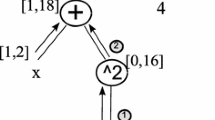Abstract
We propose a model called priority branching trees (pBT) for backtracking and dynamic programming algorithms. Our model generalizes both the priority model of Borodin, Nielson and Rackoff, as well as a simple dynamic programming model due to Woeginger, and hence spans a wide spectrum of algorithms. After witnessing the strength of the model, we then show its limitations by providing lower bounds for algorithms in this model for several classical problems such as Interval Scheduling, Knapsack and Satisfiability.
Similar content being viewed by others
References
Dimitris Achlioptas & Gregory B. Sorkin (2000). Optimal myopic algorithms for random 3-SAT. In IEEE Symposium on Foundations of Computer Science, 590–600.
M. Alekhnovich (2005). Lower bounds for k-DNF Resolution on random 3CNF. In Proceedings of the 37th Symposium on Theory of Computing, 251–256.
M. Alekhnovich, E. Hirsch & D. Itsykson (2005). Exponential lower bounds for the running time of DPLL algorithms on satisfiable formulas. Journal of Automated Reasoning 35(1-3), 51–72. Preliminary version appeared in Proceedings of the 31st International Colloquium on Automata, Languages and Programming (ICALP), 2004.
M. Alekhnovich & A. Razborov (2001). Lower bounds for the polynomial calculus: non-binomial case. In Proc. 42nd Ann. Symp. on Foundations of Computer Science. IEEE Computer Society.
Angelopoulos S., Borodin A. (2004) On the Power of Priority Algorithms for Facility Location and Set Cover. Algorithmica 40(4): 271–291
Arkin E.M., Silverberg E.L. (1987) Scheduling Jobs with Fixed Start and End Times. Disc. Appl. Math 18: 1–8
Arora Sanjeev., Bollobás Béla., Lovász László., Tourlakis Iannis (2006) Proving Integrality Gaps without Knowing the Linear Program. Theory of Computing 2(2): 19–51
Arrow Kenneth (1951) Social Choice and Individual Values. Wiley, New York
Borodin A., Nielsen M., Rackoff C. (2003) (Incremental) Priority Algorithms. Algorithmica 37: 295–326
Allan Borodin, Joan Boyar & Kim S. Larsen (2005). Priority Algorithms for Graph Optimization Problems. In Second Workshop on Approximation and Online Algorithms, volume 3351 of Lecture Notes in Computer Science, 126–139. Springer-Verlag.
J. Buresh-Oppenheim, S. Davis & R. Impagliazzo (2010). A stronger model of dynamic programming algorithms. To appear in the journal Algorithmica.
Chvátal V. (1985) Hard Knapsack Problems. Operations Research 28(6): 1402–1441
S. Cook & D. Mitchell (1997). Finding hard instances of the satisfiability problem: A survey. In DIMACS Series in Theoretical Computer Science.
Cormen T., Leiserson C., Rivest R., Stein C. (2001) Introduction to Algorithms, Second Edition. MIT Press, Cambridge, Mass
Davis M., Logemann G., Loveland D. (1962) A machine program for theorem proving. Communications of the ACM 5: 394–397
Davis M., Putnam H. (1960) A computing procedure for quantification theory. Communications of the ACM 7: 201–215
S. Davis, J. Edmonds & R.Impagliazzo (2010). Randomized priority algorithms, pBT, and free-branching pBT lower bounds. Manuscript in preparation.
S. Davis & R. Impagliazzo (2009). Models of Greedy Algorithms for Graph Problems. Algorithmica 54(3). Preliminary version appeared in the Proceedings of the 15th Annual ACM-SIAM Symposium on Discrete Algorithms (SODA), 2004.
B.C Dean, M.X. Goemans & J. Vondrák (2004). Approximating the Stochastic Knapsack Problem: The Benefit of Adaptivity. In it Proc. 44th Ann. Symp. on Foundations of Computer Science.
T. Erlebach & F.C.R. Spieksma (2002). Interval selection: Applications, algorithms, and lower bounds. Technical Report 152, Computer Engineering and Networks Laboratory, ETH.
J. Gu, P. W. Purdom, J. Franco & B. J. Wah (1997). Algorithms for the Satisfiability (SAT) Problem: A Survey. In Satisfiability (SAT) Problem, DIMACS, 19–151. American Mathematical Society.
M. Halldorsson, K. Iwama, S. Miyazaki & S. Taketomi (2002). Online Independent Sets. Theoretical Computer Science 953–962.
Håstad H. (2001) Some optimal inapproximability results. JACM 48: 798–859
Helman P. (1989) A Common Schema for Dynamic Programming and Branch and Bound Algorithms. Journal of the Association of Computing Machinery 36(1): 97–128
Helman P., Rosenthal A. (1985) A comprehensive model of dynamic programming. SIAM J. on Algebraic and Discrete Methods 6: 319–334
S.L. Horn (2004). One-Pass algorithms with revocable acceptances for job interval selection. MSc Thesis, University of Toronto.
Ibarra O., Kim C. (1975) Fast Approximation Algorithms for the Knapsack and Sum of Subset Problems. JACM 22: 463–468
A. Kaporis, L. Kirousis & E. Lalas (2003). Selecting complementary pairs of literals. In Proc. LICS‘03 Workshop on Typical Case Complexity and Phase Transitions. citeseer.ist.psu.edu/kaporis03selecting.html.
Karp R.M., Held M. (1967) Finite state processes and dynamic programming. SIAM J. Applied Mathematics 15: 693–718
Khanna S., Motwani R., Sudan M., Vazirani U. (1998) On Syntactic versus Computational Views of Approximability. SIAM Journal on Computing 28: 164–191
Knuth D.E. (1971) Optimum binary search trees. Acta Informatica 1: 14–25
E. L. Lawler (1977). Fast Approximation Algorithms for Knapsack Problems. In Proc. 18th Ann. Symp. on Foundations of Computer Science. IEEE Computer Society, Long Beach, CA.
Rajeev Motwani & Prabhakar Raghavan (1995). Randomized Algorithms. Cambridge University Press.
Oded Regev (2002) Priority algorithms for makespan minimization in the subset model. Information Processing Letters 84(3): 153–157
Vijay V. Vazirani (2001). Approximation Algorithms. Springer-Verlag.
Woeginger G. (2000) When does a dynamic programming formulation guarantee the existence of a fully polynomial time approximation scheme (FPTAS)?. INFORMS Journal on Computing 12: 57–75
Author information
Authors and Affiliations
Corresponding author
Rights and permissions
About this article
Cite this article
Alekhnovich, M., Borodin, A., Buresh-Oppenheim, J. et al. Toward a Model for Backtracking and Dynamic Programming. comput. complex. 20, 679–740 (2011). https://doi.org/10.1007/s00037-011-0028-y
Received:
Published:
Issue Date:
DOI: https://doi.org/10.1007/s00037-011-0028-y




